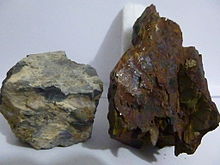Shale
The shale (from the Latin lutum, 'mud') is a clastic sedimentary rock with a very fine grain, pelitic texture, variegated; that is to say, integrated by clastic detritus constituted by particles of the sizes of clay and silt. In the black shales the color is due to the existence of organic matter. If the amount of this is very high, it is bituminous shale.
Grey, bluish-grey, white, and green colors are characteristic of slightly reducing depositional environments. Red and yellow colorations represent oxidizing environments.
Shales are porous and despite this they are impermeable, because their pores are very small and they are not well communicated between them. They can be source rocks of oil and natural gas. By metamorphism they become slates or phyllites. Its diagenesis corresponds to processes of compaction and dehydration.
Types of shale
Depending on their form of fragmentation, shales can be fissile or non-fissile. The fissils split into spatially close parallel planes. The non-fissile ones, on the other hand, split into fragments or blocks.
Shale Oil and Shale Gas
The hydraulic fracturing drilling method, due to the discovery of the "hardening" property of the pulverized fruit of the guar legume in water, allows sand to be injected into horizontal wells, which has led to the extraction of oil and natural gas contained in shales.
Contenido relacionado
Triassic
Pedrosillo de Alba
Subduction
